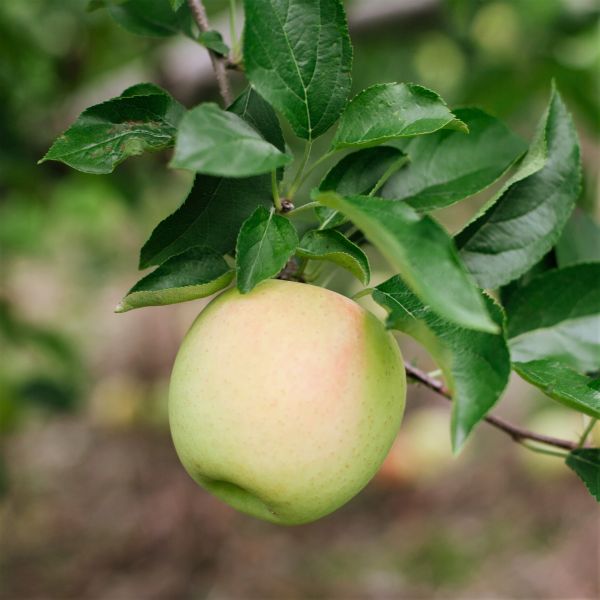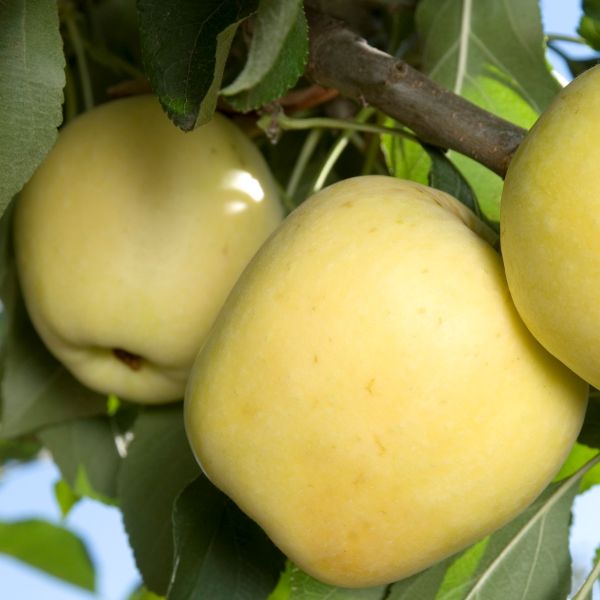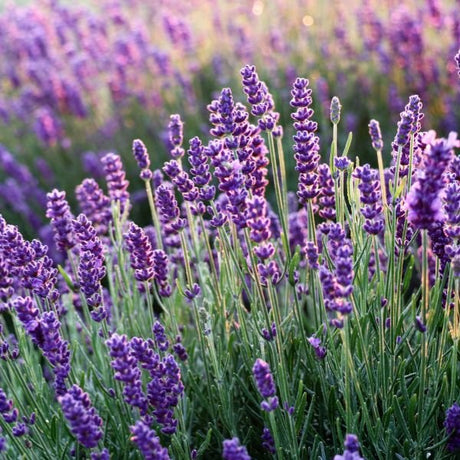Dorsett Golden Apple Tree
Malus 'Dorsett Golden'
- Stay Protected with Plant Sentry ™
Dorsett Golden Apple Tree - #1 Container is backordered and will ship as soon as it is back in stock.
Plant Sentry™
Plant Sentry™

Plant Sentry™ Protected
Your order is protected by our compliance system that:
- Prevents restricted plants from shipping to your state
- Ensures plants meet your state's agricultural requirements
- Protects gardens from invasive pests and diseases
Delivery and Shipping
Delivery and Shipping
Delivery and Shipping
Fast, Safe Plant Delivery
Ships in 3-4 business days • Tracking provided • Weather protected
| Under $50 | $9.99 |
| $50 - $99.99 | $14.99 |
| $100 - $149.99 | $16.99 |
| $150+ | $24.99 |
✓ Zone-specific timing • ✓ Professional packaging • ✓ Health guarantee
Understanding Plant Options
Nature Hills offers plants in two main formats:
- Container Plants: Grown in pots with soil, sized by container volume and plant age
- Bare Root Plants: Dormant plants without soil, sized by height measurements
Container Plant Sizes
Container sizes indicate plant age and growing capacity rather than liquid volume equivalents. Our containers follow industry-standard nursery "trade gallon" specifications, which differ from standard liquid gallon measurements.
Young Plants (6 months to 18 months old)
| Container Size | Actual Volume | Metric Equivalent |
|---|---|---|
| 2" x 2" x 3" | 0.18 - 0.21 dry quarts | 0.20 - 0.23 dry liters |
| 4" Container | 0.31 - 0.87 dry quarts | 0.35 - 0.96 dry liters |
| 4.5" Container | 0.65 dry quarts | 0.72 dry liters |
| 6" Container | 1.4 dry quarts | 1.59 dry liters |
| 1 Quart | 1 dry quart | 1.1 dry liters |
| 5.5" Container | 1.89 dry quarts | 2.08 dry liters |
Established Plants (18 months to 2.5 years old)
| Container Size | Actual Volume | Metric Equivalent |
|---|---|---|
| 2 Quart | 2 dry quarts | 2.2 dry liters |
| #1 Container | 2.26 - 3.73 dry quarts | 2.49 - 4.11 dry liters |
| 5" x 5" x 12" | 3.5 - 4.3 dry quarts | 3.85 - 4.74 dry liters |
Mature Plants (2-4 years old)
| Container Size | Actual Volume | Metric Equivalent |
|---|---|---|
| #2 Container | 1.19 - 1.76 dry gallons | 5.24 - 7.75 dry liters |
| #3 Container | 2.15 - 2.76 dry gallons | 8.14 - 12.16 dry liters |
Large Plants (3-5 years old)
| Container Size | Actual Volume | Metric Equivalent |
|---|---|---|
| #5 Container | 2.92 - 4.62 dry gallons | 12.86 - 20.35 dry liters |
| #6 Container | 5.25 - 6.01 dry gallons | 23.12 - 26.42 dry liters |
| #7 Container | 5.98 - 6.53 dry gallons | 26.34 - 28.76 dry liters |
Bare Root Plants
Bare root plants are sold by height from the root system to the top of the plant. Plants may exceed minimum height requirements.
Common Sizes:
- Trees: 1 foot, 2 feet, 3 feet, 4 feet, 5 feet, 6 feet
- Shrubs & Perennials: 1 foot, 18 inches, 2 feet
Important Notes
Container Volume Specifications
- Trade Gallon Standard: Our containers follow industry-standard "trade gallon" specifications established by the American National Standards Institute (ANSI Z60.1) for nursery stock
- Volume Variations: Actual soil volume may vary due to plant root systems and growing medium settlement
- Age Indicators: Container size primarily indicates plant age and maturity rather than liquid volume equivalents
Growing Conditions
- Plant size can vary based on variety and growing conditions
- Container size helps indicate plant maturity and establishment level
- Larger containers generally mean more established root systems and faster landscape establishment
Seasonal Availability
- Bare root plants are available seasonally when dormant
- Container plants are available throughout the growing season
- Specific varieties may have limited availability in certain sizes
Questions?
For questions about specific plant sizes or availability, please contact our plant experts who can help you choose the right size for your landscape needs.
Plant Highlights
Dorsett Golden Apple Tree highlights at a glance!
-
Botanical Name
-
Brand
-
Growing Zones6, 7, 8, 9
-
Growth RateModerate
-
Mature Height
-
Mature Width
-
Leaf Color
-
Flower Color
-
Fall Color
-
Pollinator FriendlyYes
-
Pollinator Required
-
Bloom PeriodLate Spring
-
Harvest Time
-
FragrantYes
Characteristics
Where To Plant
When To Prune
- Late Winter
Water & Moisture Needs
- Moderate
Sunlight Needs
Soil Needs
- Widely Adaptable

Growing Zones 6-9
Starts Fruiting Early Dorsett Golden Apple Tree
- Soft Golden Yellow Fruit & Sunkissed Rosy Blush
- Fragrant Rosy Pink Buds Open to Creamy White
- Spring Flowers & Fall Color
- Pollinators Love the Blooms
- Medium Sized Fruit
- Vanilla Flavor & Firm, Light & Crisp Texture
- Very Ornamental Tree!
- Great Foliage & Fall Color!
- Produces Early in Age
- Early Harvest - As Early As July
- Does Well In Warm Climates
- Needs A Pollinator Tree - Larger Yield With a Pollinator
- 100 Chill Hours
- Winner Of RHS Award Of Garden Merit
From a purely aesthetic viewpoint, the Dorsett Golden Apple (Malus 'Dorsett Golden'), brings ornamental beauty to your landscape. Each spring, it becomes blanketed in pink-tinged white blossoms that welcome in the season and send a call out to butterflies and hummingbirds.
Those blooms quickly transform with the passage of time into orbs of golden fruit with a delectable flavor! The Dorsett Golden Apple bears fruit that's medium to large in size, which is perfect for fresh-eating apples since they're not too small nor too big.
The apples have a green-tinted yellow skin with a bit of rosy to scarlet blush that marks their time spent worshiping the sun while they mature. When set against the vibrant green foliage of the tree, these beautiful apples create a show all by themselves, much to the delight of both growers and passersby.
After the harvest comes to a close, the fun isn't over with the Dorsett Golden! This tree (which sometimes fruits in its second year) creates a resplendent display of yellow, orange and red fall tones that add to your landscape and showcase mother nature's true beauty to the fullest.
How to Use Dorsett Golden Apple Tree In The Landscape
With every bite, you'll taste a slight vanilla hint with a sumptuously tart undertone. A welcome addition to the fruit bowl, these apples are very versatile. Eat them fresh, right from the tree, or slice them into an Apple pie, cobber, or crisp.
The firm flesh makes the Dorsett Golden Apple a good choice for canning and preserving, which also gives you more of your crop to enjoy later on down the road.
The lovely blooms are fragrant and call pollinators, plant around your vegetable gardens and other planting beds to provide shade. Also fantastic shade and ornamental trees around seating areas and patios.
Sized for orchards and home gardens of all sizes, pruning can keep these smaller and easier to tuck into your yard or existing orchard!
Dorsett apples are early season trees, making your summer foliage gleam with golden gems.
#ProPlantTips For Care
First developed in Nassau, New Providence Island, in the Bahamas in the 1950s and is perfectly suited to warm climates. It is really popular with growers in the warmer zones of its hardiness range of 6 - 9, as it’s one of the few low-chill apples that require less than 100 chilling hours for a successful harvest!
In fact, in very warm climates, this apple may even occasionally be evergreen.
Full sun tolerant, especially of morning sun to dry the leaves of dew that can attract fungal issues, fruit trees need at least 6 hours of direct sunlight per day. However, this tree also appreciates some afternoon shade in hotter summers, even improving the flavor of the fruit.
Requiring consistent watering in average fertility, Dorsett is not particular on the type of soil it grows in, so long as it is well-drained. Mulch to insulate the root system from heat and to further hold in more moisture.
Prune to open the canopy and allow air circulation and sunlight into the interior, further eliminating potential disease issues. Considered a vigorous grower and precocious bearer, you may find you’ll get larger fruit with some thinning. Generally, all other pruning should be done when the tree is dormant, or late winter.
Dorsett Golden is a lovely choice in an apple tree for your warm climate this year. Not only is it beautiful with spring flowers and a vibrant summer form, but it also produces an enticing harvest and spicy fall color. Why not try this award-winning Apple variety for your home today!
Call NatureHills.com right away to get this low-chill requirement, sweet-flavored tree for your home orchard before they’re gone!
Dorsett Golden Apple Tree Frequently Asked Questions
When to Plant Dorsett Golden Apple Trees
Planting Bareroot trees as soon as you can dig a hole in spring and until hot weather, the earlier the better. Plant container Apple trees throughout the growing season with complete success - that is the benefit of container plants - to extend the planting season. Your County Agricultural Extension Office is a great resource for first and last frost dates in your area.
How to Plant Dorsett Golden Apple Trees
Dig a large hole only as deep as needed to accommodate the bareroot or container root ball, and twice as wide. Add Nature Hills Root Booster to speed root establishment. Remove the pot or bag and situate it into the hole so the top of the soil (soil line if bareroot), is level with the new location's soil being careful not to plant too deep. Water in again very well and backfill with the same soil you dug up, tamping down gently to ensure there are no air pockets.
Top off with a 3-4 inch thick layer of Arborist mulch. Consider staking your tree to keep its trunk growing straight for the first year to ensure it stands tall against strong winds and drifting snow.
When to Prune Dorsett Golden Apple Trees
Trim off any broken branches from delivery as soon as you take them out of the box. Prune and trim apple trees while dormant, in late winter or early spring, before you see new growth.
How to Prune Dorsett Golden Apple Trees
Dormant prune to:
- Remove any double leaders or narrow crotch angles
- Eliminate any crossing branches
- Thin interior branching and leave the fruiting spurs and strong branches in place opening up the canopy
- Branching at least 24-36 inches above the ground
Prune Apple trees in the summer to:
- Control size and shape by reducing the length of longer new growth on vigorous trees
- Remove water sprouts on the main trunk or older branches in the crown
- Remove suckers at the base of the trunk
- Thin fruit during heavy years on established trees
How to Care for Dorsett Golden Apple Trees
Growing an apple tree is easy when proper soil, good drainage, attention to moisture, and regular fertility are maintained. Once you've chosen an apple tree that works for your climate, in the size you need for your landscape, and its pollinator (if needed), then you've accomplished half the battle!
- Apple trees do best in full sun and well-drained soil
- Water your apple trees when they get dry - especially during the fruit production stage, and drought periods to keep it stress-free
- Use arborists' wood chips to mulch over the roots of your apples and have your soil tested to see what your soil may be lacking before adding fertilizers
- Maintenance pruning and shaping
Apple trees will tolerate a wide range of soils, so long as water and nutrients are not limited and the pH level is adequate.
How to Fertilize Dorsett Golden Apple Trees
For the first year, water alone is most important. It is always best to get a soil test to see what your soil is lacking before adding more fertilizers. Once established, a fertilizer routine may be beneficial. We do offer some excellent slow-release organic options, applied according to the package directions.
Fruit trees need more phosphate and it's possible to apply too much nitrogen which affects the soil's pH. Test soil acidity or alkalinity using a pH Tester.
Fertilize in spring when you first see new growth emerging.
- Don't overdo it
- Phosphates are your friends
- Pay attention to pH in areas with extremely high or low soil pH
- Follow the directions
Dorsett Golden Apple Tree Pollinating Info
Dorsett Golden is not self-fruiting and doesn't need a pollinating partner, but will bear more fruit when paired with these varieties:
Harvest Times for Dorsett Golden Apple Trees
Dorsett Golden’s are typically ready to harvest in late June through July.
Early-Season? Mid-Season? Late-Season? The terminology can be confusing for new apple tree growers. Weather, climate and your tree determine when it's ripe.
For Apples:
- Early-season is usually June-July
- Mid-season can be August-September
- Late-season can be from late September-November
The growing season consists of spring, summer, and fall, and varies with climate and weather. Areas with longer growing seasons in the warmer hardiness zones can greatly affect the harvest times for each particular apple variety grown in your area.
What Shipping Options Do You Offer?
NatureHills.com works closely with our growers and nursery professionals to ensure we ship when it is most appropriate for your area. Our goal is to deliver the hardiest plants by avoiding extreme high and low temperatures. Check out our shipping schedule for more information and to learn our wills and won'ts when it comes to shipping plants. Find your Dorsett Golden Apple Tree for sale here at NatureHills.com!
Rootstocks Explained
Apple trees have been grafted onto different rootstocks since before the mid-1800s. Different rootstocks are used to improve the anchoring of trees, eliminate diseases, and reduce the natural mature size of the tree itself. While there are many different types of rootstock, they are all labeled as being either Dwarf, Semi-Dwarf, or Standard.
The apple descriptions, including flowering, pollination, and apple characteristics are the same whether the plant is grown on a standard rootstock or some varying dwarfing rootstock. The overall size can vary by climate and soil but the understock used is ultimately what affects the mature size.
There will be some variation in sizes but as a guide, we are suggesting the overall mature size of these apple varieties are:
Semi-Dwarf Apples
- Height: 12-18 feet
- Spread: 10 - 15 feet
Standard Apples
- Height 18 - 25 feet
- Spread: 15 - 18 feet
Remember that all fruit tree sizes can easily be altered if needed by simple pruning as the trees grow and develop.












